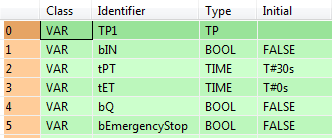


 TP
TPTimer with defined period
The function block TP allows you to program a pulse timer with a defined clock period.

Input
clock generator
if a rising edge is detected at IN, a clock is generated having the period defined in PT
clock period
16-bit value: 0–327.27s
32-bit value: 0–21,474,836.47s (32-bit value not available for FP3, FPC, FP5, FP10/10S)
resolution 10ms each
a timer having the period PT is caused for each rising edge at IN. A new rising edge detected at IN within the pulse period does not cause a new timer.
Output
signal output
is set for the period of PT as soon as a rising edge is detected at IN
elapsed time
contains the elapsed period of the timer. If PT = ET, Q will be reset
The value can be changed during counting operation by writing to the variable from the programming editor.
FP2, FP2SH and FP10SH use a 32-bit value for PT.
Independent of the turn-on period of the IN signal, a clock is generated at the output Q having a length defined by PT. The function block TP is triggered if a rising edge is detected at the input IN.
A rising edge at the input IN does not have any influence during the processing of PT.


All input and output variables used for programming this function have been declared in the POU header. The same POU header is used for all programming languages.

VAR
copy_name: TP;
start: BOOL:=FALSE;
set_value: TIME:=T#0s;
signal_output: BOOL:=FALSE;
current_value: TIME:=T#0s;
END_VARIf start is set (status = TRUE), the clock is emitted at signal_output until the set_value for the clock period is reached.


BODY
WORKSPACE
NETWORK_LIST_TYPE := NWTYPELD ;
ACTIVE_NETWORK := 0 ;
END_WORKSPACE
NET_WORK
NETWORK_TYPE := NWTYPELD ;
NETWORK_LABEL := ;
NETWORK_TITLE := ;
NETWORK_HEIGHT := 6 ;
NETWORK_BODY
B(B_CONTACT,,start,3,2,5,4,);
B(B_VARIN,,set_value,7,3,9,5,);
B(B_VAROUT,,current_value,14,3,16,5,);
B(B_COIL,,signal_output,21,2,23,4,);
B(B_FB,TP!,copy_name,9,1,14,5,,?BIN?BPT?AQ?AET);
L(1,3,3,3);
L(1,0,1,6);
L(5,3,9,3);
L(14,3,21,3);
END_NETWORK_BODY
END_NET_WORK
END_BODY
copy_name( IN:= start ,
PT:= set_value ,
Q=> signal_output ,
ET=> current_value );

All input and output variables used for programming this function have been declared in the POU header.The same POU header is used for all programming languages.

VAR
TP1: TP;
bIN: BOOL:=FALSE;
tPT: TIME:=T#30s;
tET: TIME:=T#0s;
bQ: BOOL:=FALSE;
bEmergencyStop: BOOL:=FALSE;
END_VARAfter a rising edge at IN, the timer starts counting and Q is set to TRUE. When bEmergencyStop is set to TRUE before the clock period has been elapsed, counting stops and the output Q is immediatiely reset. The timer is initialized with the clock period PT of 30s in this example.


BODY
WORKSPACE
NETWORK_LIST_TYPE := NWTYPELD ;
ACTIVE_NETWORK := 0 ;
END_WORKSPACE
NET_WORK
NETWORK_TYPE := NWTYPELD ;
NETWORK_LABEL := ;
NETWORK_TITLE := ;
NETWORK_HEIGHT := 4 ;
NETWORK_BODY
B(B_F,E_MOVE!,,16,0,22,4,,?DEN?D?AENO?C);
B(B_VARIN,,tPT,14,2,16,4,);
B(B_VAROUT,,TP1.ET,22,2,24,4,);
B(B_CONTACT,,TP1.Q,12,1,14,3,);
B(B_CONTACT,,bEmergencyStop,7,1,9,3,);
L(14,2,16,2);
L(1,2,7,2);
L(9,2,12,2);
L(1,0,1,4);
END_NETWORK_BODY
END_NET_WORK
NET_WORK
NETWORK_TYPE := NWTYPELD ;
NETWORK_LABEL := ;
NETWORK_TITLE := ;
NETWORK_HEIGHT := 5 ;
NETWORK_BODY
B(B_VARIN,,tPT,14,3,16,5,);
B(B_VAROUT,,tET,21,3,23,5,);
B(B_CONTACT,,bIN,7,2,9,4,);
B(B_COIL,,bQ,33,2,35,4,);
B(B_FB,TP!,TP1,16,1,21,5,,?BIN?BPT?AQ?AET);
B(B_CONTACT,,bEmergencyStop,27,2,29,4,N);
L(1,3,7,3);
L(9,3,16,3);
L(29,3,33,3);
L(21,3,27,3);
L(1,0,1,5);
END_NETWORK_BODY
END_NET_WORK
END_BODY
if (bEmergencyStop AND TP1.Q) then
TP1.ET:=tPT;
end_if;
TP1(IN := bIN, PT := tPT, ET => tET);
bQ := NOT bEmergencyStop AND TP1.Q;